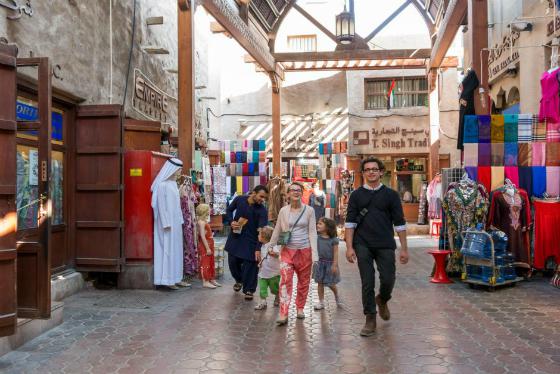The Middle East is increasingly shaping itself to become a touristic paradise. Over the past decade, the travel and tourism sector across the region has seen a sharp rise. Visitors just cannot seem to get enough of the mix of modernity and ancient culture and heritage that the region is very quickly becoming renowned for.
The UAE is one of the most prominent examples of touristic hotspots in the Middle East. Although small in size, the country’s landscape is dotted with state-of-the-art buildings and amenities, as well as places of historical and cultural interest, which are considered some of the best in the region and, indeed, across the world. Other nations such as Oman and Qatar are also focusing their efforts on attracting an increased influx of travellers from the world over.
The GCC remains the number one volume generator for tourism to Dubai, delivering the highest share of visitor volumes for 2016 with a total of 3.4 million, up five per cent over 2015.
The Annual Visitor Report 2016 released by Dubai’s Department of Tourism and Commerce Marketing (Dubai Tourism) revealed that Saudi Arabia contributed with the highest number of travellers among the GCC countries. It was followed by Oman, with Kuwait in third place and Qatar in fourth, both retaining their top 20 status.
Oman’s sizeable contribution to the 14.9m overnight visitors to Dubai last year places it in fourth spot among the emirate’s top ten source markets, with India (1.8m), Saudi Arabia (1.6m) and the UK (1.2m) leading the list.
It cannot be overlooked that the region’s travel and tourism industry needs to transform unlike never before. Truth is, the global landscape is changing very fast. Social and economic movements, coupled with widespread urbanisation, environmental change, resource shortages and technological leaps, are all coming together and influencing travel and tourism in a significant way.
A recent report by PwC, titled Global megatrends…and their impact on the Middle East’s travel and tourism industry, lists five fundamental changes which the Middle Eastern tourism industry needs to prepare for, and gear up to face challenges of the future.
1. The Changing Face of the Global Population: As the world is changing, so it its population. And no, it isn’t just expanding. Africa’s population is poised to double by 2050 – and it is the fastest-growing region in the world currently. In contrast, Europe’s population numbers are predicted to fall. The average age of a human being in Japan is going to be 53, whereas in Nigeria it is going to be 23.
This vast difference is poised to have dire implications country-wise and worldwide. Reports released by the UN indicate that people who are aged 60 years and above are going to account for 21 percent of the world’s overall population. Of course, this isn’t exactly good news for world economies, but the travel and tourism industry will get to welcome a new-category traveller – the silver tourist.
2. The Changing Face of Demand: Earlier, the travel and tourism sector had travellers that were at most middle-aged and interested in leisure of limited options. Today, however, the scenario has changed tremendously. The industry is changing the way it works to suit the demands of tourists of all ages across the world.
Traveller demands and choices are evolving extremely fast. While the shifting demands opens up more opportunities for the travel and tourism sector, it poses various challenges as well, because the diversity in demand is becoming more and more polarized. The “Gen Z” traveller category – tourists who are highly educated and have high access to information – are poised to usher in a new wave of growth in the travel and tourism industry.
3. The Changing Face of Economies: Most of the muscle of the world economy is now getting increasingly shared by emerging economies – Asia, Africa, and Latin America. And the Middle is situated rather strategically in the midst of all the action. This geographic coincidence cannot be left unconsidered.
Indian and Chinese economies are holding their own as the two most influential economies and Middle Eastern nations are reaping – and still can continue to reap – a lot of benefits from their growing markets. The way things are panning out, by 2030, Asia-Pacific countries are well-placed to witness the most tourist arrivals.
4. The Nexus between Urbanisation and Tourism: At present, more than half of the world’s population is settled in cities. The Gulf region is speeding up its urbanisation game and leading the pack. As the “urban sprawl” gets more expansive, the travel and tourism industry is poised to experience the after effects. Opportunities galore will be available – but unfortunately, so will the challenges. Governments will need to up their game as proper planning, investment, and infrastructure will be required to measure up to the demands of the growing numbers.
5. Climate Change and Technological Breakthroughs: Climate change and resource scarcity are realities that the travel and tourism sector has to deal with as it continues to expand. GCC nations are amongst the world’s highest users of energy and water resources, and it is common knowledge that these resources are fast depleting.
Middle Eastern think tanks will need to innovate and invent new ways to meet their countries’ demands for natural resources. Furthermore, digitisation is also a challenge that Middle Eastern countries need to warm up to and devise ways to use it to their advantage to improve the travellers’ experience.
AMEINFO
21 June
























































